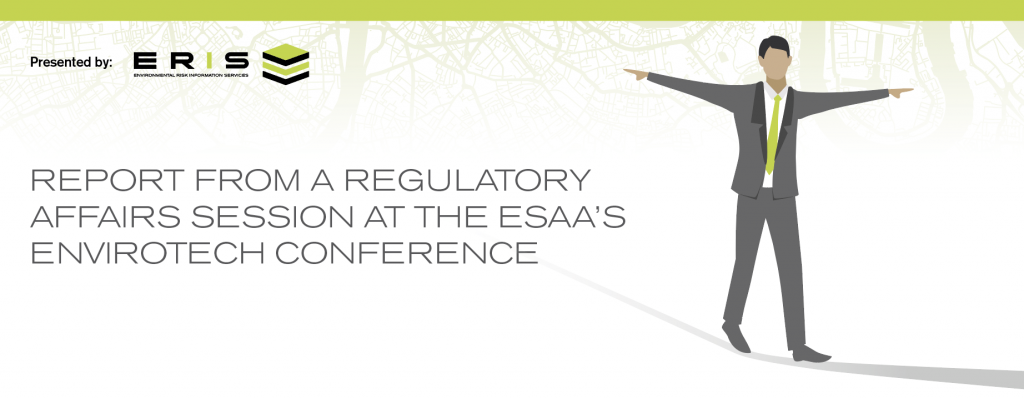Environmental practice in 2020 – Balancing on a tight rope

 by Guy Crittenden
by Guy Crittenden
Content Developer for ERIS
Toronto, Ontario
[email protected]
August 27, 2020
Click here to download the PDF version ![]()
This article summarizes the second presentation in the Regulatory Affairs session from EnviroTech 2020 — an annual conference presented by the Environmental Services Association of Alberta (ESAA) that was delivered this year online due to COVID-19 restrictions. The session occurred on Thursday, June 11, 2020.
Featured panelists: Jacquelyn Stevens, Partner, LSO Certified Specialist in Environmental Law, Willms & Shier Environmental Lawyers LLP. Michelle L. Heffernan, B.Sc., P.Ag., Partner, Senior Environmental Scientist, Trace Associates Inc.
Introduction: Framing the Discussion
Trace Associates’ Michelle Heffernan began by acknowledging that 2020 is a difficult year for everyone, due to the economic strain and the global pandemic.
“Environmental professionals are on a tightrope meeting client expectations,” Heffernan said, “plus the expectations of regulators, land owners, and third parties while producing quality work and operating in a way that’s professionally prudent and safe.”
Heffernan said previous discussions with co-presenter Jacquelyn Stevens about a range of topics led to them narrowing the field down to three:
- Reporting releases and historical contamination;
- Limited scopes and inheriting sites / work products; and
- Environmental services during COVID-19.
Spill Reporting and Notification to Regulators
When to report or notify regulators of spills or historical contamination has long been a grey area, according to the presenters. The discovery of contamination doesn’t always fit neatly into the “spill” category (where reporting requirements are clear, and tools and forms are readily accessible). The industry standard has been to report historic contamination if contaminants are detected moving offsite, or if known adverse effects are immediate.
“It’s those older sites where it’s less clear when we should be reporting,” Trace Associates’ Heffernan stated, noting that the industry is discussing what the best practices should be. Heffernan gave the example of a well site that changed hands multiple times, for which a Phase 1 and Phase 2 environmental site assessment (ESA) had been conducted, and for which a drilling waste disposal area was identified that had been impacted by hydrocarbons. It was unclear when the waste had been disposed and by which previous owner.
“The question is, ‘When do we report it? Who reports it?” Heffernan asked referring to property owners, licensees or stakeholders.
Willms & Shier’s Jacquelyn Stevens replied that there’s no bullet proof answer, but that she could offer some guidance.
Jurisdictions May Interpret Differently
“You need to look at the laws and regulations in your jurisdiction,” she said, noting that the wording is important and the meaning of many of the words have been litigated. She showed paraphrases of wording in three different jurisdictions (Alberta, Saskatchewan and British Columbia) to highlight the similarity and differences, as they pertain to reporting.
Words and phrases that have been litigated and whose meaning may be important and vary from place to place include such items as “release,” “causes or permits,” “report,” “causes or may cause.” “adverse effect,” “person having control of a substance,” “charge, management or control,” “while conducting work,” etc. Meanings vary and so it’s important to have your legal team in place as technical staff go about their work.
Is It Your Obligation to Report?
Does the consultant have any obligation with respect to reporting? Heffernan asked.
“You have an obligation to your client,” Stevens answered (if a spill or release is detected), which is an obligation of confidentiality and other obligations outlined in the retainer agreement.
The requirements of your professional designation apply, as do the laws and regulations. The consultant must report what they find to their client, and then an assessment can be made to determine whether the spill or release must be reported.
“Consultants may have a duty to report regardless of what their client does or doesn’t do, and should seek legal advice,” Stevens said.
Heffernan asked Stevens whether examples exist of legal action being taken for failure to report releases or historical contamination.
 How Is ‘Failure to Report’ Defined?
How Is ‘Failure to Report’ Defined?
Stevens replied that the failure to report is an offence, and is often part of a list of offences that are prosecuted. She cited the case of R v Edmonton (City) (2006) which expanded on and clarified the language in a statute, in light of a question about whether or not a release had occurred.
“The court actually spent 69 pages looking at and considering the words of the statute and what they meant and how they had been treated in previous cases, and just how they should be looked at in terms of their ordinary meaning,” Stevens said.
“In the Edmonton case,” Stevens added, “the court also looked at the creation of a secondary category or class of person who may be required to report aside from the actual polluter.” The court also looked at theterm“charge,management and control” and indicated the phrase should not be considered only in its ordinary meaning but also a purposive meaning.” This expands the meaning of “charge, management and control” of the property. There’sno “one size fits all criteria.” The person (e.g., an owner) who discovers the contamination may not be the person who released it, but they may have an obligation to report, according to Stevens.
There’sno “one size fits all criteria.” The person (e.g., an owner) who discovers the contamination may not be the person who released it, but they may have an obligation to report, according to Stevens.
How Case Factors are Assessed
“Each case has to be assessed based on the facts: What was spilled? When was it spilled? How much was spilled? Did it cause an adverse effect? Can it cause an adverse effect?” Stevens said, by way of listing questions that go beyond simply, “Do I have a duty to report historic contamination?”
To illustrate this, Stevens referred to three cases of immediate releases: R v Chem-Security (Alberta) Ltd. (1998); R v Shell Canada Limited et al (2000); and R v Agrium Inc. (2019). The cases demonstrated a range of technically different situations and nuanced reporting requirements and problems with failure to report or failure to report sufficient details. (Stevens notes there are fewer prosecutions related to failure to report historic contamination, as in those cases the issue usually concerns failure to clean up a site or comply with a control order, rather than failure to report.)
Challenges: Client-defined Scope & Inherited Projects
In the tough economic climate, and limited budgets, companies are sometimes forced to reduce the scope of work and cut costs, Heffernan noted, adding that the approved scopes are often more limited than serves the interests of a well-informed conclusion about a site.
“Consultants may inherit work from other consultants that may not be reliable as a foundation in moving forward to the next stage,” Heffernan said. She asked Stevens how consultants can balance client budgets and needs with the expectations of regulators.
“That’s a question we get often,” Stevens answered before elaborating a couple of key components mostly tied to communication with the client. The consultant needs to clarify the objectives and purpose of the work and integrate these with their expertise and knowledge of science and also regulatory requirements (i.e., the consultant’s experience submitting reports to regulators and what’s likely to be acceptable to them). In some instances where a client rejects the full scope of work recommended by the consultant, the consultant can include in their report that the conclusions are based on the constrained scope of work approved by the client.
 Some Guidance Around Inherited Sites
Some Guidance Around Inherited Sites
The presenters also discussed guidance available with respect to steps consultants should take when inheriting sites or work produced by other consultants. Questions include asking whether the previous consultant reviewed the full suite of documents you would review (in a Phase One ESA)? Did they go out and interview entities at the property? Did they properly assess whether a Phase Two is warranted, or not? It may be necessary to advise the client about any data gaps identified in the previous work that need filling.
“It’s really important to document instructions from your client,” Stevens said, as well as to follow best practices of relevant professional designations and organizations.
What’s Essential During COVID-19?
The session concluded with the presenters discussing some of the unique challenges of performing environmental work during the COVID-19 crisis and lockdown. Clients and the public have struggled with what’s considered an essential service at this time, plus scope of work (including monitoring and reporting requirements) in the face of orders, decisions and guidance that’s evolving and sometimes confusing.
“If a service is considered essential, is the scope of work also essential?” Heffernan asked.
She cited some sites where approvals or orders mandate that a scope be completed, but where some of the requirements have been relaxed. In some instances, the direction from different regulatory bodies have differed from one another, creating confusion.
 Provinces and Territories Differ
Provinces and Territories Differ
Stevens confirmed that each province and territory has its uniquely different list of the services deemed “essential”. The federal government offered overall guidance, but each province differs and in some areas this can be confusing. Stevens reviewed some examples from restricted and non-restricted services in the industrial, public safety and security, and energy/oil and gas sectors. Some reporting deadlines have been extended or suspended. In Alberta, she noted, Alberta Environment and Parks (AEP) and Alberta Energy Regulator (AER) differ in their approaches. She reviewed AER decisions from May 20, 2020 that affect a range of industries including suspension of some monitoring requirements for operators in the oil and gas industry including soil and groundwater monitoring, VOC and RSC monitoring, etc. (Note: on June 23, 2020, the May 20, 2020 AER decisions were amended, resulting in reinstatement of all requirements for monitoring and activities incidental to monitoring as of July 15, 2020.)
Don’t Expect Regulatory Lenience
The session ended with audience Q&A and a discussion of whether leniency will be extended for non-compliance during these stressful times. Stevens recommended talking to regulators about any need to modify compliance obligations, and not to simply assume leniency will be extended for failure to comply with monitoring and/or reporting requirements in the time of COVID-19. AEP, for instance, says spring monitoring will be required.
ERIS would like to thank the ESAA Executive Director and EnviroTech Conference Chair Joe Chowaniec for his help in organizing this year’s event and making it a success in the face of many challenges. To learn more about the ESAA and next year’s EnviroTech conference, visit ESAA.org
